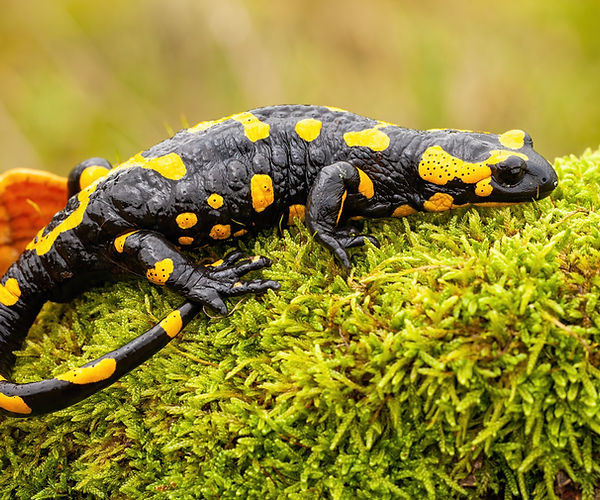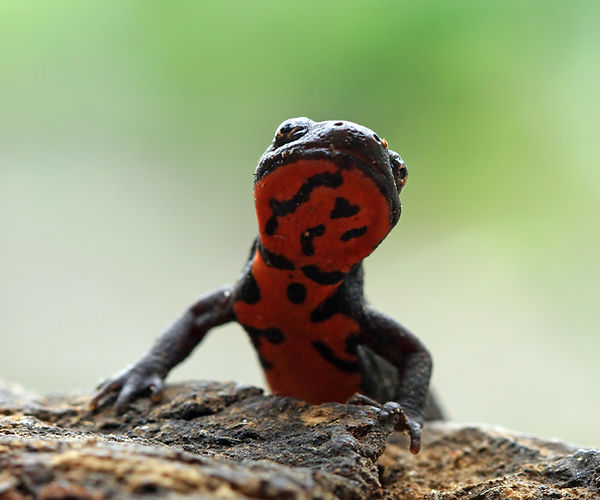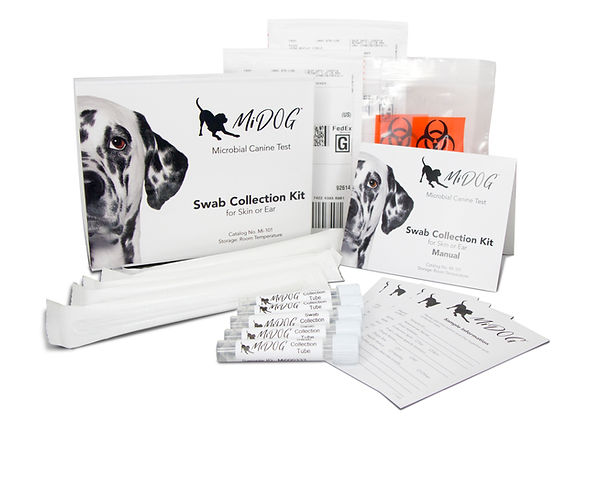
Fungal diseases pose an alarming problem for salamanders, with chytrid disease.
Salamander chytrid disease, also known as salamander chytridiomycosis, is an infectious fungal disease that has had significant impacts on the biodiversity of salamanders in Asia and Europe within the last decade [1]. While the disease is not yet present in North America, it is critical to know the warning signs of this fast spreading disease should chytridiomycosis invade native salamander populations. Just in Europe, an outbreak of chytrid disease was associated with a greater than 96% mortality rate in fire salamanders [2].
The good news is that increased transmission of this fungal disease has triggered a renewed interest in veterinary research in this field, resulting in promising studies regarding diagnoses and treatment. If you believe your pet salamander (or frog or newt) is showing clinical signs of chytrid disease, call your veterinarian immediately.
What is Chytrid Disease?
Salamander chytridiomycosis is an infectious disease caused by the fungus Batrachotrytrium salamandrivorans (Bsal), which is a close relative of B. dendrobatidis (Bd) [2]. Bsal is able to kill host salamanders by parasitizing its skin cells and ultimately causing significant skin ulceration and degradation [3]. Within two to three weeks after exposure death occurs due to the extensive skin damage impairing basic skin function, such as fluid balance, protection against opportunistic pathogens, electrolyte homeostasis, and more [3]. Bizarre posturing and behavior has been associated with Bsal. The key difference between the closely related Bsal and Bd fungi is the differing pathogenicity in various species: Bsal is more pathogenic in salamanders (specifically fire salamanders), while Bd is more pathogenic in frog species [3]. Clinical signs for both Bsal and Bd infections include but are not limited to:
- excessive skin shedding
- lethargy
- anorexia
- abnormal posture
- death
- skin ulcerations and significant destruction of the epidermis in Bsal infections (less common in Bd infections)
Notably, some studies suggest various types of frogs, but more specifically bull frogs, may be a potential carriers of chytridiomycosis and can exhibit resistance to the highly infectious spores of Bsal [3]. A 2-year study assessing a chytrid outbreak in Belgium unveiled that fire salamanders are unable to develop immunity to the fungus, unlike other amphibians [2]. Moreover, the fungus creates “a hardy spore that can survive in water for months and also stick to birds’ feet, offering a way for it to spread rapidly across a continent” [4].

Fire salamanders are particularly prone to fungal chytrid infections.
How is Chytrid Fungi Transmitted in Salamanders?
Increasing research suggests that transmission of chytrid fungus occurs due to contact with water or organic material (such as mud, leaves, etc.) or by direct contact with a chytrid-infected salamander [2]. The zoospores released by the fungus are able to survive in water and moist environments, and are even able to actively swim short distances [5]. If you suspect your pet salamander is suffering from an infection, it is extremely important to isolate your salamander from other pets to prevent further transmission of the fungus. In general, good animal husbandry can help prevent transmission of infections and shedding of pathogens. As the Manual of Exotic Pet Practice puts it, “the majority of diseases observed in captive amphibians are directly associated with improper husbandry” [6]. While it may seem obvious that cleaning your pet’s terrarium is important in warding off infections, cleanliness cannot be overstated.
Diagnosing Fungal Infections in Salamanders
Considering the gravity of a potential Bsal outbreak in North America, multiple studies implore the usage of molecular testing in amphibian diagnostics. Specifically, there is a need “for accurate, specific, and sensitive molecular and tissue-based diagnostic tests for the identification of Bsa” [5]. As it stands, the current diagnostic criteria for confirming Bsal chytridiomycosis necessitates a positive histopathology test for a Bsal infection alongside confirmatory molecular diagnostics. One study differentiating Bsal and Bd in amphibian chytridiomycosis using RNA sequencing technology underscores the importance of integrating molecular diagnostics into veterinary amphibian care, as these tests are superior to culture-based studies, which are less likely to differentiate Bd and Bsal (both of which have drastically different outcomes in different amphibians!) [5].
The MiDOG All-in-One Microbial Test may provide the answer to the diagnostic conundrum that fungal infections pose for you and your salamander. Utilizing NGS technology to detect and quantify all microbial DNA through untargeted and comprehensive sequencing and quantitative comparisons to reference databases, the MiDOG NGS technology provides a useful opportunity to shed light on the microbial makeup of your amphibian’s fungal infection for clinical application. The MiDOG microbial test is grounded on scientific research that provides veterinarians DNA evidence for the guided treatment of amphibian fungal infections, such as chytridiomycosis.

Find out if your vet uses MiDOG before you book your next appointment!
For health-related questions about your reptile or other exotic pet, reach out to a veterinarian that specializes in exotic pets.
References:
[1] Spitzen – van der Sluijs, A., Stegen, G., Bogaerts, S. et al. Post-epizootic salamander persistence in a disease-free refugium suggests poor dispersal ability of Batrachochytrium salamandrivorans. Sci Rep 8, 3800 (2018). https://doi.org/10.1038/s41598-018-22225-9
[2] SALAMANDER CHYTRIDIOMYCOSIS. (2022). Retrieved 15 April 2022, from http://www.cwhc-rcsf.ca/docs/fact_sheets/Salamander_Chytridiomycosis_Fact_Sheet.pdf
[3] Gray, M., Lewis, J., Nanjappa, P., Klocke, B., Pasmans, F., & Martel, A. et al. (2015). Batrachochytrium salamandrivorans: The North American Response and a Call for Action. PLOS Pathogens, 11(12), e1005251. doi: 10.1371/journal.ppat.1005251
[4] Stokstad, E. (2017). A deadly salamander disease just got a lot scarier. Retrieved 15 April 2022, from https://www.science.org/content/article/deadly-salamander-disease-just-got-lot-scarier
[5] Ossiboff, R., Towe, A., Brown, M., Longo, A., Lips, K., & Miller, D. et al. (2019). Differentiating Batrachochytrium dendrobatidis and B. salamandrivorans in Amphibian Chytridiomycosis Using RNAScope®in situ Hybridization. Frontiers In Veterinary Science, 6. doi: 10.3389/fvets.2019.00304
[6] Deczm, M. M. D. M. P. & Tully Jr. DVM MS DABVP (Avian) DECZM (Avian), Thomas N. (2008). Manual of Exotic Pet Practice (1st ed.). Saunders.
Categories: Exotic Pets, Reptiles/Amphibians

